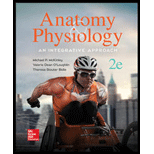
Concept explainers
_____ 1. All of the following are phagocytic cells except
- a. neutrophils.
- b. T-lymphocytes.
- c. macrophages.
- d. eosinophils.
Introduction:
The phagocytosis is the process in which the cells eliminate the pathogens by engulfing them. The substances which are engulfed by the cell may be infectious agents, cellular debris. This is a very common process for food intake in amoebas.
Answer to Problem 1DYKB
Correct answer:
The T-lymphocytes secrete cytokines and activate other cytotoxic T-lymphocytes to invade the pathogens. Therefore, option b. is correct.
Explanation of Solution
Reason for the correct statement:
Option b. is given as “T-lymphocytes”. The T-lymphocytes are the cells which provide protection against the antigens by releasing cytokines and also activate the cytotoxic cells which further release other cytokines. The infectious antigens are eliminated by the cytokines, not by phagocytosis process. Hence, the T-lymphocytes are not the phagocytic cells.
Hence, option b. is correct.
Reasons for incorrect statements:
Option a. is given as “neutrophils”. The neutrophils’ function is to destroy infectious agents through a process known as phagocytosis. It is the process in which the infectious agent is engulfed by the neutrophils. Neutrophils are phagocytic cells. Hence, option a. is incorrect.
Option c. is given as “macrophages”. The macrophages also involve the phagocytosis process in which the engulfed infectious agent is covered to form phagosome and interact with lysosomes to release a residue in the external environment. Macrophages are phagocytic cells. Hence, option c. is incorrect.
Option d. is given as “eosinophils”. Eosinophils also participate in the immune response associated with allergy and asthma and are involved in phagocytosis of antigen-antibody complexes. Eosinophils are phagocytic cells. Hence, option d. is incorrect.
Hence, options a., c., and d. are incorrect.
The neutrophils, macrophages, and eosinophils all are phagocytic cells because they show phagocytosis, but T-lymphocytes releases cytokines to eliminate pathogens.
Want to see more full solutions like this?
Chapter 22 Solutions
Anatomy & Physiology: An Integrative Approach
- students in a science class investiged the conditions under which corn seeds would germinate most successfully. BAsed on the results which of these factors appears most important for successful corn seed germination.arrow_forwardI want to write the given physician orders in the kardex formarrow_forwardAmino Acid Coclow TABle 3' Gly Phe Leu (G) (F) (L) 3- Val (V) Arg (R) Ser (S) Ala (A) Lys (K) CAG G Glu Asp (E) (D) Ser (S) CCCAGUCAGUCAGUCAG 0204 C U A G C Asn (N) G 4 A AGU C GU (5) AC C UGA A G5 C CUGACUGACUGACUGAC Thr (T) Met (M) lle £€ (1) U 4 G Tyr Σε (Y) U Cys (C) C A G Trp (W) 3' U C A Leu בוט His Pro (P) ££ (H) Gin (Q) Arg 흐름 (R) (L) Start Stop 8. Transcription and Translation Practice: (Video 10-1 and 10-2) A. Below is the sense strand of a DNA gene. Using the sense strand, create the antisense DNA strand and label the 5' and 3' ends. B. Use the antisense strand that you create in part A as a template to create the mRNA transcript of the gene and label the 5' and 3' ends. C. Translate the mRNA you produced in part B into the polypeptide sequence making sure to follow all the rules of translation. 5'-AGCATGACTAATAGTTGTTGAGCTGTC-3' (sense strand) 4arrow_forward
- What is the structure and function of Eukaryotic cells, including their organelles? How are Eukaryotic cells different than Prokaryotic cells, in terms of evolution which form of the cell might have came first? How do Eukaryotic cells become malignant (cancerous)?arrow_forwardWhat are the roles of DNA and proteins inside of the cell? What are the building blocks or molecular components of the DNA and proteins? How are proteins produced within the cell? What connection is there between DNA, proteins, and the cell cycle? What is the relationship between DNA, proteins, and Cancer?arrow_forwardWhy cells go through various types of cell division and how eukaryotic cells control cell growth through the cell cycle control system?arrow_forward
 Medical Terminology for Health Professions, Spira...Health & NutritionISBN:9781305634350Author:Ann Ehrlich, Carol L. Schroeder, Laura Ehrlich, Katrina A. SchroederPublisher:Cengage Learning
Medical Terminology for Health Professions, Spira...Health & NutritionISBN:9781305634350Author:Ann Ehrlich, Carol L. Schroeder, Laura Ehrlich, Katrina A. SchroederPublisher:Cengage Learning Comprehensive Medical Assisting: Administrative a...NursingISBN:9781305964792Author:Wilburta Q. Lindh, Carol D. Tamparo, Barbara M. Dahl, Julie Morris, Cindy CorreaPublisher:Cengage Learning
Comprehensive Medical Assisting: Administrative a...NursingISBN:9781305964792Author:Wilburta Q. Lindh, Carol D. Tamparo, Barbara M. Dahl, Julie Morris, Cindy CorreaPublisher:Cengage Learning Human Heredity: Principles and Issues (MindTap Co...BiologyISBN:9781305251052Author:Michael CummingsPublisher:Cengage Learning
Human Heredity: Principles and Issues (MindTap Co...BiologyISBN:9781305251052Author:Michael CummingsPublisher:Cengage Learning





